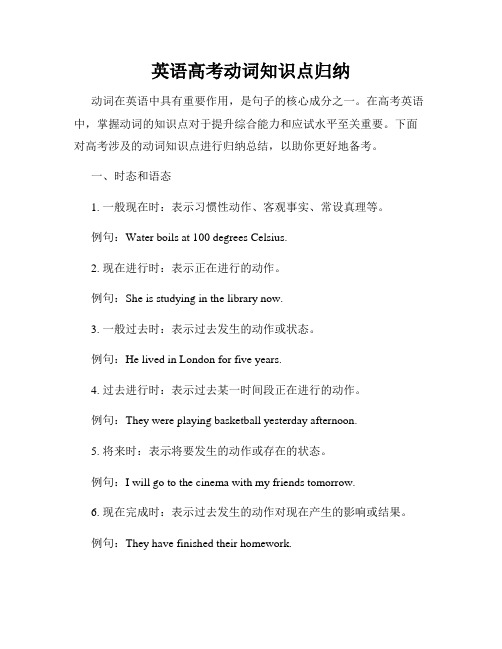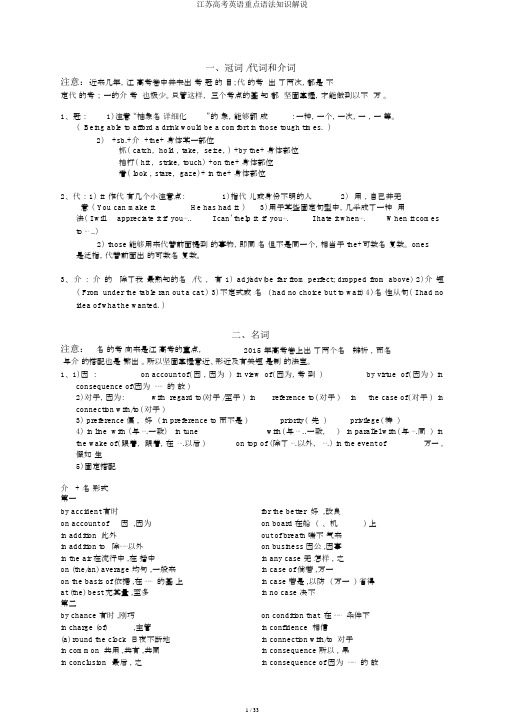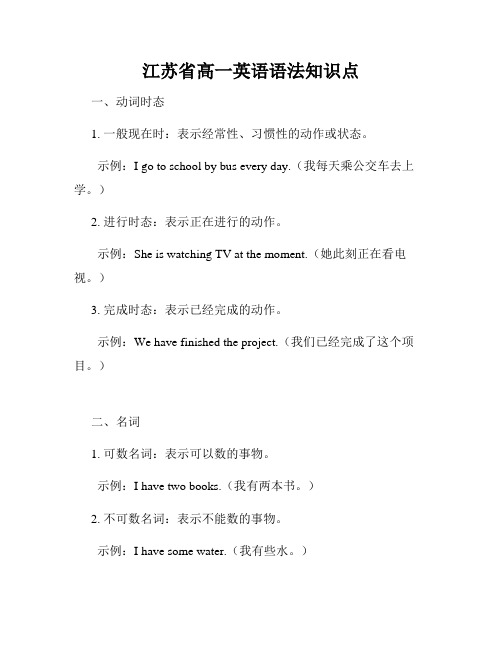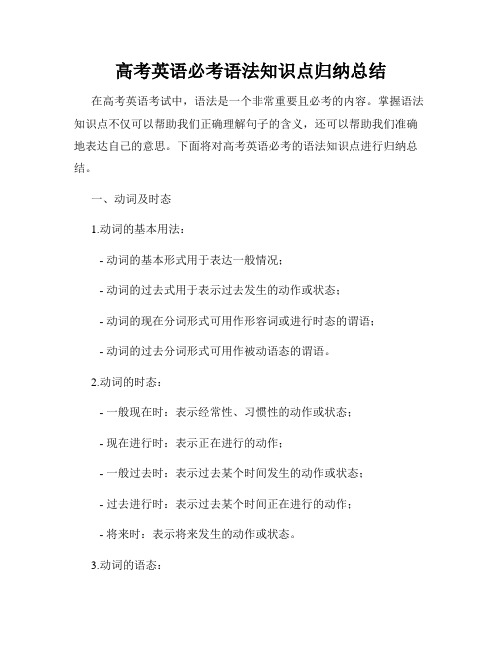江苏高考英语复习动词所有用法梳理
江苏高考英语语法专题复习知识点汇总(可编辑修改word版)

知识要点:江苏高考英语语法专题复习知识点汇总一、冠词The Article冠词是一种虚词,放在名词的前面,帮助说明名词的含义。
冠词分不定冠词(The Indefinite Article)和定冠词(The definite Article)两种。
a (an) 是不定冠词,a 用在辅音之前:如a book, a man; an 用在元音之前,如:an old man, an hour, an interesting book 等。
the 是定冠词。
一、不定冠词的用法1、指人或事物的某一种类(泛指)。
这是不定冠词a (an)的基本用法。
如:She is a girl. I am a teacher. Please pass me an apple.2、指某人或某物,但不具体说明何人或何物。
如:He borrowed a story-book from the library.A Li is looking for you. 一位姓李的同志正在找你。
3、表示数量,有“一”的意思,但数的概念没有one 强烈。
如:I have a mouth, a nose and two eyes.4、用于某些固定词组中。
如:a bit, a few, a little, a lot of, a piece of, a cup of, a glass of, a pile of, a pair of, have a good time, for a while, for a long time 等。
5、用在抽象名词前,表具体的介绍——a + 抽象名词,起具体化的作用。
如:This little girl is a joy to her parents. 这女孩对她父母来说是一个乐趣。
It is a pleasure to talk with you. 跟您交谈真是一件愉快的事情。
It is an honour to me to attend the meeting. 参加这个会,对我来说是一种荣誉。
江苏高考英语必背知识点归纳

江苏高考英语必背知识点归纳高考英语作为一门英语水平测试科目,对于广大学子来说非常重要。
掌握一些必背的英语知识点,不仅能够提高自己的英语水平,还能在高考中取得更好的成绩。
针对江苏高考英语科目,我将对一些必背知识点进行归纳和总结,希望能给大家的备考提供一些帮助。
一、词汇与语法1. 时态和语态时态和语态是英语中非常重要的语法知识点。
高考中经常涉及到的时态有一般现在时、一般过去时、一般将来时、现在进行时和过去进行时等。
而语态主要包括主动语态和被动语态。
掌握时态和语态的基本用法以及相应的句型结构对于高考英语的应试非常关键。
2. 词义辨析高考英语中常常出现一些词义辨析的题目,例如同义词、反义词、近义词等。
对于这类题目,需要我们对词义有较为准确的理解和掌握。
可以通过背诵一些常用词汇、短语和惯用语来提升自己的词汇量,增强对词义辨析的能力。
3. 连词用法在高考英语中,连词是构建复杂句的重要工具。
各类连词的使用有其特定的语法规则。
例如,表示因果关系的连词有because、since、as等;表示递进关系的连词有besides、furthermore、in addition等等。
掌握各类连词的用法可以帮助我们更好地理解和分析句子结构,准确回答题目。
二、阅读理解1. 主旨理解阅读理解题中经常出现的一类问题就是关于文章主旨的问题。
针对这类问题,我们应该通过捕捉文章的核心思想,理解作者的写作意图,找到文章的主题和中心发展线索。
平时,我们可以多读一些英文文章,提高自己的阅读速度和理解能力。
2. 推理判断推理判断题要求我们根据已有信息,进行逻辑推理和判断。
针对这类题目,我们需要细读文章,准确理解文章内容,同时也要善于运用逻辑思维进行推理。
积极参加阅读理解的练习,做到看得准,理解透。
3. 文章细节阅读理解题中还会有一些关于文章细节的问题。
对于这类问题,我们需要细致阅读并理解文章内容,留意文章中的一些具体细节信息,如人物、事件、时间、地点等。
英语高考动词知识点归纳

英语高考动词知识点归纳动词在英语中具有重要作用,是句子的核心成分之一。
在高考英语中,掌握动词的知识点对于提升综合能力和应试水平至关重要。
下面对高考涉及的动词知识点进行归纳总结,以助你更好地备考。
一、时态和语态1. 一般现在时:表示习惯性动作、客观事实、常设真理等。
例句:Water boils at 100 degrees Celsius.2. 现在进行时:表示正在进行的动作。
例句:She is studying in the library now.3. 一般过去时:表示过去发生的动作或状态。
例句:He lived in London for five years.4. 过去进行时:表示过去某一时间段正在进行的动作。
例句:They were playing basketball yesterday afternoon.5. 将来时:表示将要发生的动作或存在的状态。
例句:I will go to the cinema with my friends tomorrow.6. 现在完成时:表示过去发生的动作对现在产生的影响或结果。
例句:They have finished their homework.7. 过去完成时:表示过去某一时间点之前已经发生的动作或存在的状态。
例句:I had already eaten dinner when he arrived.8. 被动语态:强调动作的承受者或结果。
例句:The book was written by Mark Twain.二、情态动词1. can/could:表示能力、允许、请求等。
例句:She can swim very well.2. may/might:表示可能性、许可、建议等。
例句:You may borrow my book.3. must:表示必须、推测等。
例句:You must finish your homework before watching TV.4. will/would:表示意愿、打算、愿意等。
江苏高考英语重点语法知识讲解

一、冠词 /代词和介词注意:近来几年,江高考卷中并未出考冠的目;代的考出了两次,都是不定代的考;一的介考也极少。
只管这样,三个考点的基知都坚固掌握,才能做到以不万。
1、冠:1)注意“抽象名详细化”的象,能够翻成: 一种,一个,一次,一,一等。
(Being able to afford a drink would be a comfort in those tough times. )2) +sb.+介 +the+ 身体某一部位抓( catch, hold ,take, seize,) +by the+ 身体部位拍打( hit , strike,touch) +on the+ 身体部位看( look ,stare, gaze)+ in the+ 身体部位2、代: 1) it 作代有几个小注意点:1)指代儿或身份不明的人2)用,自己并无意( You can make it. He has had it. )3)用于某些固定句型中,几乎成了一种用法( I will appreciate it if you⋯..I can’thelp it if you⋯.I hate it when⋯.When it comes to ⋯ ..)2) those能够用来代替前面提到的事物,即同名但不是同一个,相当于 the+可数名复数。
ones 是泛指,代替前面出的可数名复数。
3、介:介的除了我最熟知的名/代,有 1) adj/adv(be far from perfect; dropped from above) 2)介短( From under the table ran out a cat.) 3)不定式或名 ( had no choice but to wait) 4)名性从句( I had no idea of what he wanted. )二、名词注意:名的考向来是江高考的重点,2015 年高考卷上出了两个名辨析,而名与介的搭配也是繁出。
江苏高考语法知识点汇总

江苏高考语法知识点汇总江苏高考对语法的要求较为严格,考查的知识点也相对较多。
下面将对江苏高考中常见的语法知识点进行汇总,帮助同学们复习备考。
一、主谓一致1. 单数主语与单数谓语动词相搭配,复数主语与复数谓语动词相搭配。
- The book is on the table.(单数主语)- The books are on the table.(复数主语)2. 谓语动词的用法:a. 一般现在时:主语为第三人称单数,动词加s或es。
- She teaches English at school.b. 现在进行时:主语+am/is/are+现在分词。
- They are playing basketball.3. 单数主语连同 each, every, either, neither 或者表示时间、距离和金额的词搭配时,谓语动词用单数形式。
- Each of us is responsible for our own choices.- Neither of the boys has finished their homework.二、代词1. 人称代词的正确使用:- 主格:I, you, he, she, it, we, they- 宾格:me, you, him, her, it, us, them- 形容词性物主代词:my, your, his, her, its, our, their- 名词性物主代词:mine, yours, his, hers, its, ours, theirs2. 指示代词的用法:- This 近指,指离说话人或看到的人或物;- That 远指,指离说话人和听话人都不近的人或物;- These 复数近指,指离说话人或看到的人或物;- Those 复数远指,指离说话人和听话人都不近的人或物。
3. 不定代词的正确使用:- everyone, nobody, somebody, anybody, nobody等作主语时,谓语动词用单数。
最新高考英语(江苏)语法精讲+精练:专题五+动词时态和语态常考点[15页]
![最新高考英语(江苏)语法精讲+精练:专题五+动词时态和语态常考点[15页]](https://img.taocdn.com/s3/m/6cd5b19e2e3f5727a4e962b3.png)
专题五 动词时态和语态常考点在高考英语中,动词的时态和语态是重中之重,试题在考查固定句式中的时态和语态的同时,注重在上下文语境中考查时态和语态。
要了解几种时态的一些常规规则,答题时要研读题干,搜索出尽可能多的“时间参照信息”,尤其要注意时态的呼应情况。
时态主动语态形式被动语态形式一般现在时am/is/are/do/does am/is/are done一般过去时was/were/did was/were done现在完成时has/have done has/have been done 现在完成进行时has/have been doing/现在进行时am/is/are doing am/is/are being done过去进行时was/were doing was/were being done过去完成时had done had been done将来完成时will/shall have done will /shall have been done一般将来时will /shall doam/is/are going to doam/is/are coming/leavingam/is/are to doam/is/are about to dowill /shall be doneam/is/are to be done 过去将来时would dowas going to dowas coming/leavingwas to dowas about to dowould be donewas/were to be done 将来进行时will /shall be doing/ 一般现在时1一般现在时表示动作的经常性或真理;表示现状、性质、状态时多用系动词或状态动词;在条件、时间、让步状语从句中用一般现在时或现在完成时表示将来;表示预计或规定;方位副词或介词短语放在句首,主语是名词,且全部倒装时,用一般现在时表示正在发生的动作;还可使用于文学作品和文学评论中。
江苏省高一英语语法知识点

江苏省高一英语语法知识点一、动词时态1. 一般现在时:表示经常性、习惯性的动作或状态。
示例:I go to school by bus every day.(我每天乘公交车去上学。
)2. 进行时态:表示正在进行的动作。
示例:She is watching TV at the moment.(她此刻正在看电视。
)3. 完成时态:表示已经完成的动作。
示例:We have finished the project.(我们已经完成了这个项目。
)二、名词1. 可数名词:表示可以数的事物。
示例:I have two books.(我有两本书。
)2. 不可数名词:表示不能数的事物。
示例:I have some water.(我有些水。
)三、形容词和副词1. 形容词:用来描述名词的特征。
示例:She is a beautiful girl.(她是一个漂亮的女孩。
)2. 副词:用来修改动词、形容词或其他副词。
示例:He runs very fast.(他跑得非常快。
)四、代词1. 人称代词:代替特定的人或人群。
示例:I am a student. He is a teacher.(我是一名学生。
他是一名老师。
)2. 物主代词:表示所有关系。
示例:This is my book.(这是我的书。
)3. 反身代词:指示动作的主体同时也是动作的受益者。
示例:She hurt herself.(她伤到了自己。
)五、连接词1. 并列连词:连接并列关系的词语。
示例:I like coffee and tea.(我喜欢咖啡和茶。
)2. 转折连词:连接相反关系的词语。
示例:He is rich, but he is not happy.(他很有钱,但并不快乐。
)3. 因果连词:连接原因和结果关系的词语。
示例:I was late for work, because my alarm didn't go off.(我上班迟到了,因为我的闹钟没响。
高考英语必考语法知识点归纳总结

高考英语必考语法知识点归纳总结在高考英语考试中,语法是一个非常重要且必考的内容。
掌握语法知识点不仅可以帮助我们正确理解句子的含义,还可以帮助我们准确地表达自己的意思。
下面将对高考英语必考的语法知识点进行归纳总结。
一、动词及时态1.动词的基本用法:- 动词的基本形式用于表达一般情况;- 动词的过去式用于表示过去发生的动作或状态;- 动词的现在分词形式可用作形容词或进行时态的谓语;- 动词的过去分词形式可用作被动语态的谓语。
2.动词的时态:- 一般现在时:表示经常性、习惯性的动作或状态;- 现在进行时:表示正在进行的动作;- 一般过去时:表示过去某个时间发生的动作或状态;- 过去进行时:表示过去某个时间正在进行的动作;- 将来时:表示将来发生的动作或状态。
3.动词的语态:- 主动语态:表示主语进行或完成动作;- 被动语态:表示主语接受动作。
二、代词1.人称代词:- 主格代词用作主语;- 宾格代词用作宾语或介词的宾语;- 形容词性物主代词用于修饰名词;- 名词性物主代词在句中充当名词的作用;- 反身代词表示动作的主体同时也是动作的承受者。
2.指示代词:- 指示代词可用于指示距离的远近或在句中代替特定的事物。
3.不定代词:- 不定代词用于代替不确定或泛指的人或事物。
三、形容词和副词1.形容词:- 形容词修饰名词,用于描述或限定名词。
2.副词:- 副词修饰动词、形容词或其他副词,用于描述或限定动作的方式、程度等。
四、句型和从句1.简单句:- 简单句由主语和谓语构成,能够独立表达一个完整的意思。
2.并列句:- 并列句由两个或多个独立的分句组成,各分句之间用连词连接。
3.复合句:- 复合句包括一个主句和一个或多个从句。
4.定语从句:- 定语从句用来修饰一个名词或代词,并且不能独立成句。
5.名词性从句:- 名词性从句可以在句子中充当主语、宾语或表语。
五、形式和语气1.直接引语和间接引语:- 直接引语是原话的直接陈述或引述;- 间接引语是对原话的复述或改写。
- 1、下载文档前请自行甄别文档内容的完整性,平台不提供额外的编辑、内容补充、找答案等附加服务。
- 2、"仅部分预览"的文档,不可在线预览部分如存在完整性等问题,可反馈申请退款(可完整预览的文档不适用该条件!)。
- 3、如文档侵犯您的权益,请联系客服反馈,我们会尽快为您处理(人工客服工作时间:9:00-18:30)。
动词原形及不定式的用法动词原形的用法1.除单三人称的一般现在时,其它人称作主语,动词用原形。
2.将来时态shall, will, should, would之后用动词原形。
3.祈使句句子开头用动词原形。
4.助动词do, does, did之后用动词原形。
5.情态动词can、could、may, might, have/has to, must, need, dare ,ought to之后用动词原形。
6.使役动词let、make、have 之后用动词原形。
7.感官动词see、watch、notice、hear、feel、find之后用动词原形(说明动作已经结束)。
8.had better 之后用动词原形。
9.why / why not 之后用动词原形。
10.would rather dosth . than do sth .11.prefer to dosth. rather than do sth./ prefer doing sth. to doing sth.动名词的用法1.介词之后动词要用动名词形式(动词+ing)2.部分动词之后的动词只能用动名词形式:enjoy, finish, practice, mind, spend,dislike, find , keep3.部分短语后省略了介词in: have fun/ problems/ difficulties/trouble /a good time doing be busy doing,4.be worth doing, can’t help doing , feel like doing , do some doing sth.5.下面这些动词既可跟动名词又可跟不定式:like / love / hatedoing (doing表示习惯)(to do表示具体的动作)stop doing(表示停止)(doing表示开始做不定式的动作);remember , forget (不定式表示未做;动名词表示已做);try (doing表示试着做;to do表示努力做);go on (doing继续做相同的事to do继续做不同的事)begin , start (to do与doing区别不大);need (人作主语用to do ;物作主语用doing表示被动);mean(人作主语用to do表示“打算做”;事/ 物作主语用doing表示“意味着”);这些动词既可跟动词原形,又可跟ing形式:see,watch,hear.notice (用原形是指动作结束,ing 表示动作正在进行)动词不定式的用法1.ask/tell/want/order/teach/wish/wouldlike/invite/encourage sb. to do sth.2.ask/tell/want/order/teach/wish/wouldlike/invite/encourage sb. not to do sth.3.Help...(to) dosth.4.主系表+ 不定式(to do)5.主系表+for sb + 不定式(to do)6.部分动词既可跟动名词又可跟不定式:(同动名词6)7.疑问词+不定式(to do)可以把复合句变为简单句,(to = 主语+will/would/can)英语动词双写规则及常见动词英语动词双写规则必须同时满足以下4 个条件1) 该动词的发音以重读闭音节结尾;重读闭音节就是指在一个音节中,元音字母不是发它本身的字母音,以辅音字母结尾,而且是重读音节的音节。
比如apple划音节就应该是ap/ple前面那个ap是一个音节以辅音字母结尾就是闭音节。
2)结尾闭音节符合“1 个辅音字母+ 1 个元音字母+ 1 个辅音字母”3)结尾的辅音字母不是"x";4)该动词的拼写规则没有例外;如:sit---sitting/begin---beginning(重读在gin这个音节上,相当与把gin改成双写的)像travel这种重读不在的vel,可以为travelled,也可以是traveled.举两个很经典的例子:forbid---forbidding(重读闭音节,双写)prohibit---prohibiting(重读在第二音节,非重读闭音节,不双写)情态助动词用法简述1.dare, need①dare作情态动词用时, 常用于疑问句、否定句和条件从句中, 过去式形式为dared。
例How dare you say such horrible words to me?②need 作情态动词用时, 常用于疑问句、否定句,相当于肯定句中一般用must, have to, ought to, should。
例Need I finish the work today?Yes, you must. / No, you needn’t.③dare和need作实义动词用时,有人称、时态和数的变化,在肯定句中,dare后面常接带to的不定式,在疑问句和否定句中,dare后面可接带to或不带to的不定式,而need后面只能接带to的不定式。
例She doesn’t dare (to)answer.2.shall, should①shall 用于第一人称,征求对方的意见。
例:What shall I do ?②shall 用于第二、三人称,表示说话人给对方的命令、警告、允诺或威胁。
例:You shall be punished,you bad boy!3.will, would①表示请求、建议等,使用would使语气更加缓和。
例Would you give me a cup of coffee, please?②表示意志、愿望和决心。
例I will never do that again.③would表示过去反复发生的动作或某种倾向。
例During that summer, he would visit me everyother day.④表示估计和猜想。
例It would be about may when she come back toChina.4.should, ought to①should表示“应该”,ought to表示义务或责任,语气更严重。
例I should help her because she is introuble.②表示劝告、建议和命令,should, ought to可通用,但在疑问句中常用should。
例Should I open the window?③表示推测,should , ought to (客观推测), must(主观推测)。
例She must pass the exam. (断定)能充当谓语的动词1.定义:能够充当句子谓语的动词就是主动词(main verb)例Reading makes a full man. (make在这句话里为主动词)2.类别:①连系动词:用来表示身份,状态,性质,特征,无法单独使用,和表语一起构成系表结构A 状态系动词:包括be动词,continue,keep,stay,remain,stand等例The girl keeps crying.(持续的哭的状态)B 表象系动词:表示“看起来像”,包括look,seem,appear等例She looks like her mother.C 感官系动词:与人的五感有关,嗅觉,听觉,视觉,味觉,触觉,包括feel,look,sound,smell,taste 例It taste good.D 变化系动词:表示从一种状态变化至另一种状态,包括get,become,turn,dome,grow,fall等例Yesterday's little girl becomes today'sbeautiful woman.②实义动词:及物动词和不及物动词例I agree with you.(及物)The game begins.(不及物)* 实义动词又分为短暂性动词和持续性动词,短暂性动词一般不用while引导,可做状语表示一段时间,但持续性动词不可以。
常见主动表被动不定式作后置定语,放在被修饰词后面,不定式与前面被修饰的名词或代词有动宾关系,又在句子中与另一名词或代词有主谓关系,此时,不定式要用主动表被动含义。
例如:I have much workto do. 我有许多要做的事情。
(与work有动宾关系,与I有主谓关系)Jay is looking fora room to live in. Jay在找一间住的房间。
(与room有动宾关系,与Jay 有主谓关系)She has a familyto support.她要维持一个家庭。
(与family有动宾关系,与she有主谓关系)不定式修饰作表语和宾语补足语的形容词时,如下difficult, easy,comfortable (舒适的、安逸的),convenient(便利的,方便的),hard, cheap,expensive, 等此时结构为:主语+系动词+形容词+ 不定式;动词+宾语+形容词+不定式。
例如:The question isquite difficult to answer. 这个问题真的很难以回答。
The work is easyto do. 这项工作很轻松。
I found the buscomfortable to ride in. 我觉得这种公交车坐着很舒服。
